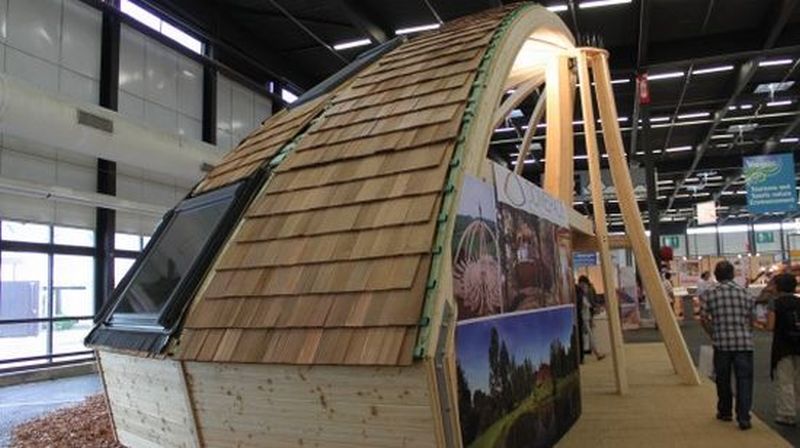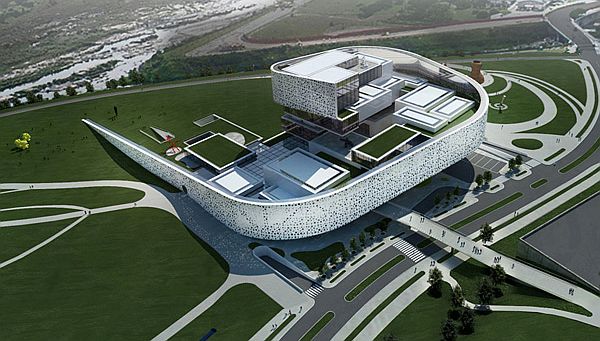Rise in global temperature
Naysayers argue that global warming is a natural progression and even if humans were to cease their activities, the earth’s atmosphere would still witness temperature rise. Nonetheless, human activity is significantly contributing to the burgeoning global warming.
The greenhouse effect is essential to our survival, keeping the earth warm enough for us and other living beings to thrive. The problem arises when too much heat is trapped in the atmosphere owing to increased emission of gases like methane, carbon dioxide and nitrous oxide. According to scientists, since 1925, the earth’s temperature has risen by 1.5 degrees Fahrenheit.
What we’re seeing now are melting polar ice caps, an increase in the number of storms in the North Atlantic, an average of 15 every year as opposed to 10 before the year 1990, and a rise in carbon emissions in almost every country of the world.
Melting of glaciers
Most proponents of global warming have cited melting of glaciers and ice caps as a clear indicator of the greenhouse effect. According to a study, six major glaciers from the Greenland Ice Sheet recorded the same initial ice buildup in six years and each of these glaciers witnessed a slowdown during the warm years, when a greater amount of melt water was produced. Countries in low lying areas are at risk of being submerged if melting of glaciers continues at the current rate. Three main areas have been identified as being especially vulnerable.
1. Palau, Micronesia: Palau has gained recognition after figuring in the list of Seven Underwater Wonders of the World. The Pacific Island nation has a very rich underwater life, beckoning divers and researchers to study its rich biodiversity. Despite efforts to protect the area, however, Palau may just end up underwater if current trends continue.
2. Great Barrier Reef, Australia: Australia’s Great Barrier Reef is the largest coral reef system on the planet. Harboring 2,900 individual reefs, it’s a hot bed of marine activity. But, if waters rise, acidity levels can change and this could ultimately kill the reefs. As it is, Australia’s slow efforts to curb its carbon emissions has already led to substantial damage to the Great Barrier Reef.
3. Maldives, Indian Ocean: Maldives is already witnessing significant erosion on its borders. Aside from climate change, human activities like reclamation, illegal sand and coral mining have led to some houses collapsing because of sand bank erosion.
The future of architecture
Opinions are divided on the concept of climate change, as we all know and many companies, environmentalists and governments have called for change in policies to halt global warming. Architects and designers have already dreamed up housing projects that seek to minimize impact on the environment by utilizing green, non polluting energy and making provisions for effective waste management. An example is the Float House by Arman Fissette, which attempts to make use of Western Europe’s canal banks. The ‘house’ can either float or lean over an embankment, taking up just a meter of space so as not to affect canal traffic.
Your world of tomorrow
The five concepts listed below don’t envision living beneath the earth’s crust but do project surviving in underwater cities.
Taiwan Skyscraper
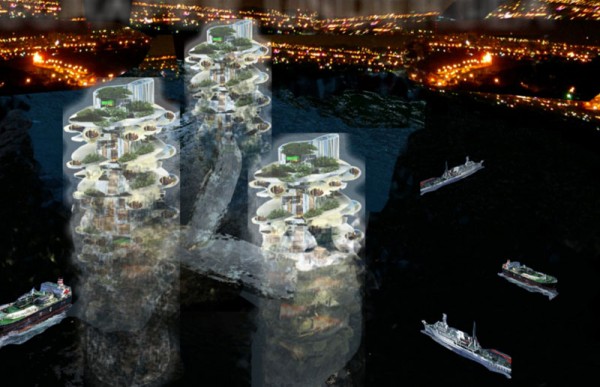
As part of the Annual Skyscraper Competition of 2006-09, Taiwanese designers came up with a concept of an underwater skyscraper that is self sustaining. The structure has an upper level garden as well as spheres that house offices, residences and lounges. Translucent soft plastic tubes act like elevators, transporting occupants from one level to the next. Food will be grown in the skyscraper itself and waste water will be properly treated for reuse. Electricity will be produced through solar, tidal and wind energy.
Gyre
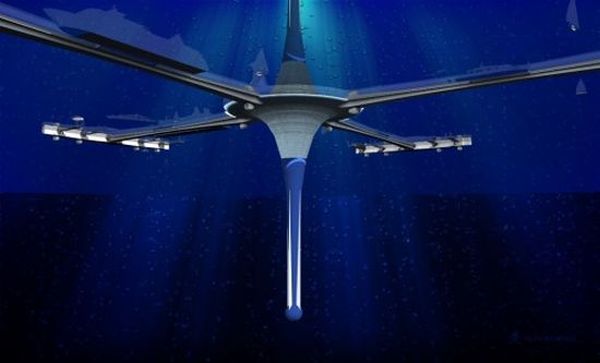
Home design studio, Zigloo, created the Gyre Seascraper concept, an underwater science lab and resort at a dept of 400m, capable of housing gardens, offices, shops, restaurants, residences and recreational areas. A double hulled vortex covered in reinforced glass with concentric rings for each layer, Gyre will be powered by renewable energy through solar cells and wind turbines. Underwater nacelles will act like tidal generators when Gyre is anchored and function as thrusters for propulsion.
Undersea Scraper, self sufficient tower
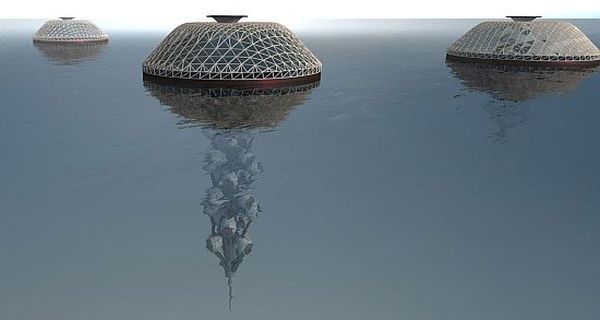
The Undersea Scraper designed by Spanish architects lfigeneia Arvaniti and Higinio Llames, hopes to give future victims of climate change some respite. The structure is self sufficient with the building’s skin having the capability of interacting with the surroundings for generation of tidal power. The dome, meanwhile, converts solar energy into power through photovoltaic generators. The double skin of the Undersea Scraper enables it to float or submerge by acting as a ballast tank.
Scraper city
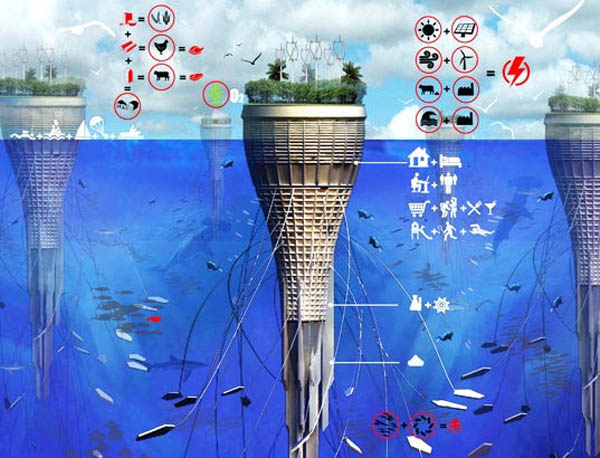
Malaysian designer, Sarly Adre Bin Sarkum, drew up a concept for the eVolo Skyscraper Competition titled the Water Scraper, which envisions integrating a floating island with an underwater skyscraper. The self sufficient structure generates renewable power by utilizing solar, wind and wave energy, and also produces its own food via aquaculture, farming and hydroponic techniques. A small forest dominates the top of the skyscraper while the lower levels house living spaces. Ballasts and tentacle like protrusions keep the Water Scraper upright.
Underwater Skyscraper 7 by De Bever architects

Conceived by De Bever architects, the Underwater Skyscraper 7 seeks to harmonize living with underwater surroundings. Not many details have been given but from what we can see, the city will house about 6,000 inhabitants with layers of concentric circles acting as living spaces.
The benefits
1. Underwater skyscrapers will give vacationers and scientists a safe and non polluting platform to understand the world of oceans.
2. The structures will utilize renewable and clean energy as well as grow food through aquaculture, farming and hydroponics.
3. The skyscrapers will give us a way out and provide us shelter when effects of global warming reach an alarming stage, making living on land next to impossible.
4. Underwater cities use green technology and energy and we might eventually see mankind forever shedding his dependence on conventional energy systems.
The challenges
While underwater skyscrapers do give us an alternative, it’s obvious that they come with many drawbacks.
1. Sea storms: No technology can keep sea storms at bay and this poses a huge problem for underwater living.
2. Transportation: Since roads won’t be used anymore, we’d have to build whole new transport systems.
3. High humidity: Humidity is higher under water and there are no solutions yet on how to accommodate growing populations.
4. High cost: The cost of building underwater infrastructure will be huge, more than land based living.
The bottom line
There’s no doubt that underwater cities seem like an attractive solution to global warming. But, how do we ensure that air, water and food quality will be maintained? Moreover, how do we ensure that the ecosystem will be left undamaged by our activities? The sheer volume of work and capital needed to make underwater living feasible is one of the biggest obstacles we’d have to overcome. A far simpler and cost effective solution is turning our lifestyle around by incorporating green energy, proper waste management and innovative architecture in our way of life.



